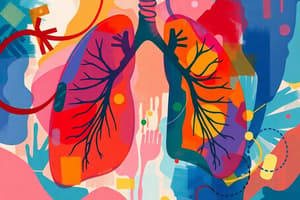Podcast
Questions and Answers
Which of the following physiological processes is directly facilitated by ventilation?
Which of the following physiological processes is directly facilitated by ventilation?
- Movement of air into and out of the lungs. (correct)
- The exchange of oxygen and carbon dioxide in the lungs.
- Regulation of blood pH through bicarbonate buffering.
- Metabolism of nutrients within individual cells.
Where does external respiration primarily occur in the respiratory system?
Where does external respiration primarily occur in the respiratory system?
- Within the mitochondria of body cells.
- Inside the hemoglobin molecules within red blood cells.
- Between the alveolar and capillary membranes. (correct)
- In the interstitial fluid surrounding lung tissues.
Which aspect of a patient's condition is assessed by auscultating lung sounds?
Which aspect of a patient's condition is assessed by auscultating lung sounds?
- The symmetry of chest expansion during breathing.
- The presence of adventitious sounds or abnormalities in the lungs. (correct)
- The partial pressure of carbon dioxide in arterial blood.
- The oxygen saturation level in the blood.
Which parameters are directly measured by arterial blood gas (ABG) analysis?
Which parameters are directly measured by arterial blood gas (ABG) analysis?
What is the primary function of the photodetector sensor in a pulse oximetry device?
What is the primary function of the photodetector sensor in a pulse oximetry device?
A patient is having difficulty breathing. How would a healthcare provider use the Fowler position to assist?
A patient is having difficulty breathing. How would a healthcare provider use the Fowler position to assist?
Which of the following describes the primary mechanism by which pursed-lip breathing improves oxygenation?
Which of the following describes the primary mechanism by which pursed-lip breathing improves oxygenation?
Which of the following is a key consideration for the use of portable oxygen tanks?
Which of the following is a key consideration for the use of portable oxygen tanks?
Why is an oxygen analyzer used in oxygen administration:
Why is an oxygen analyzer used in oxygen administration:
In what scenario might a Venturi mask be most appropriate?
In what scenario might a Venturi mask be most appropriate?
When is a tracheostomy collar typically used?
When is a tracheostomy collar typically used?
What is a potential hazard of oxygen therapy?
What is a potential hazard of oxygen therapy?
What is the key feature of hyperbaric oxygen therapy?
What is the key feature of hyperbaric oxygen therapy?
An elderly patient presents with new-onset confusion. How does an inadequate oxygenation typically affect their status?
An elderly patient presents with new-onset confusion. How does an inadequate oxygenation typically affect their status?
Why do inactive, debilitated, or chronically ill clients have a compromised respiratory function?
Why do inactive, debilitated, or chronically ill clients have a compromised respiratory function?
Flashcards
Inspiration & Expiration
Inspiration & Expiration
The process of breathing in (inspiration) and out (expiration).
Ventilation
Ventilation
Movement of air in and out of the lungs, which facilitates respiration.
Respiration
Respiration
The exchange of oxygen and carbon dioxide in the body.
External Respiration
External Respiration
Signup and view all the flashcards
Internal Respiration
Internal Respiration
Signup and view all the flashcards
Pulse Oximetry (SpO2)
Pulse Oximetry (SpO2)
Signup and view all the flashcards
Arterial Blood Gas (ABG)
Arterial Blood Gas (ABG)
Signup and view all the flashcards
Fowler's Position
Fowler's Position
Signup and view all the flashcards
Deep Breathing
Deep Breathing
Signup and view all the flashcards
Pursed-Lip Breathing
Pursed-Lip Breathing
Signup and view all the flashcards
Oxygen Source
Oxygen Source
Signup and view all the flashcards
Flowmeter
Flowmeter
Signup and view all the flashcards
Nasal Cannula
Nasal Cannula
Signup and view all the flashcards
Simple Mask
Simple Mask
Signup and view all the flashcards
Hyperbaric Oxygen Therapy
Hyperbaric Oxygen Therapy
Signup and view all the flashcards
Study Notes
Oxygenation Fundamentals
- Oxygen accounts for roughly 21% of Earth's atmosphere.
- Oxygen is used by human body cells to metabolize nutrients and create energy.
- Without oxygen, cells die quickly.
Breathing Anatomy and Physiology
- Breathing involves inspiration and expiration.
- Ventilation pertains to air movement in and out of the lungs, which helps respiration.
- Respiration is the process of exchanging oxygen and carbon dioxide.
- The exchange of gases between the alveolar and capillary membranes located at the most distal point in the airway is known as external respiration.
- Internal respiration occurs within body cells via hemoglobin.
Assessing Oxygenation
- Physical assessment includes:
- Monitoring respiratory rate.
- Observing breathing patterns and effort.
- Checking for chest symmetry.
- Auscultating lung sounds.
- Arterial blood gas (ABG) assessment measures:
- Partial pressure of oxygen (PaO2) and carbon dioxide (PaCO2) dissolved in plasma.
- Percentage of hemoglobin saturated with oxygen.
- pH of blood.
- Level of bicarbonate ions.
- Pulse oximetry (SpO2) is a noninvasive method for continuously or periodically monitoring oxygen saturation.
- It uses a photodetector sensor, a red and infrared light emitter, and a microprocessor.
Promoting Healthy Oxygenation
- Positioning i.e. Fowler's position aids in oxygenation.
- Breathing techniques to support healthy oxygenation include:
- Deep breathing, including incentive spirometry
- Pursed-lip breathing
- Diaphragmatic breathing
- Using nasal strips
Oxygen Therapy
- Oxygen can be sourced from:
- Wall outlets
- Portable tanks
- Liquid oxygen units
- Oxygen concentrators
- Equipment for administering oxygen include:
- Flowmeters
- Oxygen analyzers
- Humidifiers
- Common oxygen delivery devices include:
- Nasal cannulas
- Simple masks
- Partial rebreather masks
- Non-rebreather masks
- Venturi masks
- Face tents
- Tracheostomy collars
- T-pieces
- Nasal catheters
- Transtracheal oxygen
- Oxygen tents
- Oxygen therapy has hazards like:
- Fire potential
- Oxygen toxicity
Related Oxygenation Techniques
- Positive airway pressure machines exist using:
- CPAP masks
- BiPAP masks
- Water-seal chest tube drainage
- Hyperbaric oxygen therapy involves:
- Delivery of 100% oxygen at three times the normal atmospheric pressure within an airtight chamber.
Gerontologic Considerations
- As people age, gas exchange and ventilation efficiency decrease.
- Diminished cough and gag reflexes, increased use of accessory muscles for breathing, increased mouth breathing, and snoring may occur.
- Changes in lung volume result in decreased overall efficiency and increased energy expenditure.
- It is important to differentiate restlessness or confusion as signs of inadequate oxygenation versus delirium or dementia.
- Inactive, debilitated, or chronically ill clients or smokers are at a higher risk for respiratory infections and compromised respiratory function
Studying That Suits You
Use AI to generate personalized quizzes and flashcards to suit your learning preferences.




